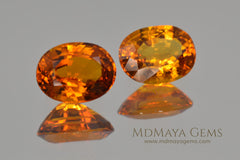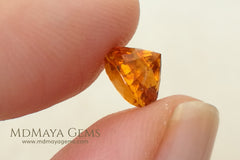Your cart (0)
Your cart is empty
Tax included and shipping calculated at checkout
Drawer menu
Tax included and shipping calculated at checkout
Clinohumite is a rare gemstone from the Humite mineral group. Revered for its golden glow and scarcity, Clinohumite also carries a legend that echoes through the Pamir Mountains — a tale of the sun, the mountains, and fiery protection.
Contenido
The legend of this rare gemstone says that the inhabitants of the Pamir Mountains were under the protection of the SUN. The sun helped them in their harsh life at the mountains, and illuminated them in the most difficult times. They were usually attacked by nomads, and thanks to their ally, the sun, they could hide in the mountains.

But one day, the nomads attacked the inhabitants of the mountain almost at night. As much as the sun tried to guide the way, the mountain prevented every ray of light. So that the sun had to fight with the mountains and move them, for his proteges could find shelter.

It was a merciless struggle between the mountains and the sun, and while the mountain inhabitants managed to take shelter, in the end the sun ended up losing the battle and cutting himself with the jagged mountain peaks.
From that day on, the inhabitants started to found beautiful YELLOW gemstones, which are nothing more than pieces of the sun. The natives of Pamir Mountains called it the Fire Mountain.

For centuries, the inhabitants of the Pamir Mountains have sought these beautiful yellow gems for protection or as amulets; these stones are considered great gifts at weddings, births, etc and are placed both cradles and tombs, seeking the protection of our loved ones and as a treasure, they are passed from generation to generation.
COLORS: Honey yellow, light yellow, orange, brown yellow, brown, reddish brown.

The Clinohumite gemstone quality is not usually found in larger SIZES to 3 ct. with an average of 1 ct. Because of its rarity, as refered to CUT, it tries to maximize the gross. Clinohumite faceted quality gem has a high value.
The clinohumite is a fairly rare member of the family group of humite, with a hardness of 6 (Mohs' scale), usually opaque o translucent and rarely presented in gem quality, that is transparent, with few inclusions and a beautiful color.
Due to its fragility and rarity, they are not usually used in jewellery, since any pressure could fracture the gem.

Solid inclusions (cristals), bifasic inclusions, growth lines of different orange, healed fractures, etc..
GENESIS: Metamorphic of contact.
Clinohumite major producers of gem quality: there are few known places of gem-quality deposits: (Taimyr) Russia, (Magenhe) Tanzania, (Pamir - associated with high quality spinel deposits), Tajikistan.
TREATMENTS: No treatments.
SYNTHESIS: Not synthetized.

|
Solid inclusions Healed fracture, two-phase inclusions, Growth lines of different orange |
Magnesium Silicate, humite group (Mg, Fe2+)9 (SiO 4)4 (F, OH)2 It was first discovered in 1876 by Alfred Vesuvius Des Clozeaux. Etymology: Klinos, derived from the Greek word: bent.
|
Clinohumite is more than a rare gemstone — it’s a radiant piece of legend and light. Whether you're drawn to its golden glow, its story of protection, or its collector's value, this exceptional gem deserves a special place in your heart — and your collection.
Explore our limited Clinohumite gemstones and bring a spark of legend into your next jewelry creation.